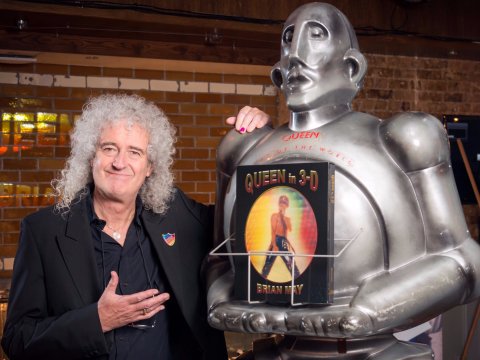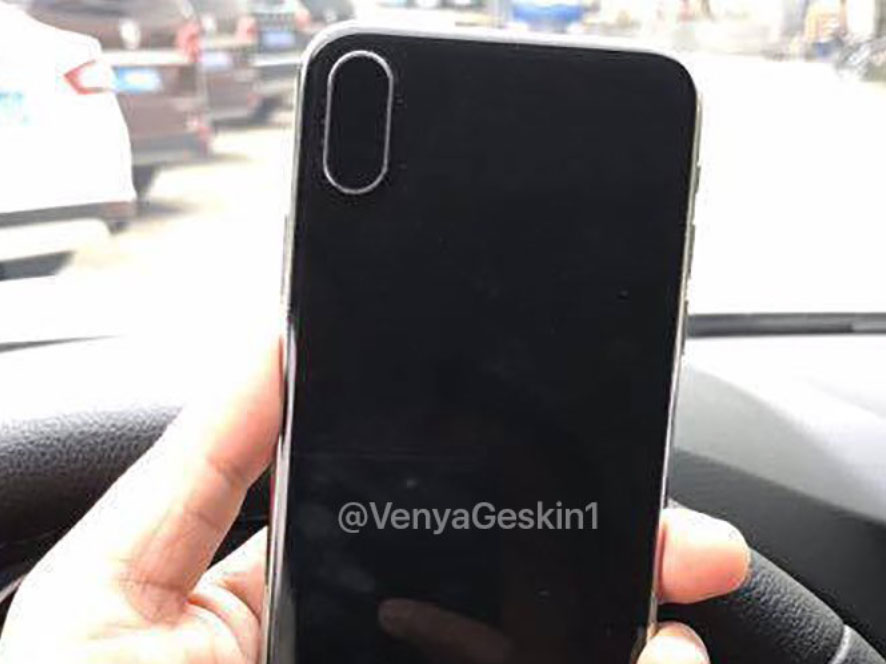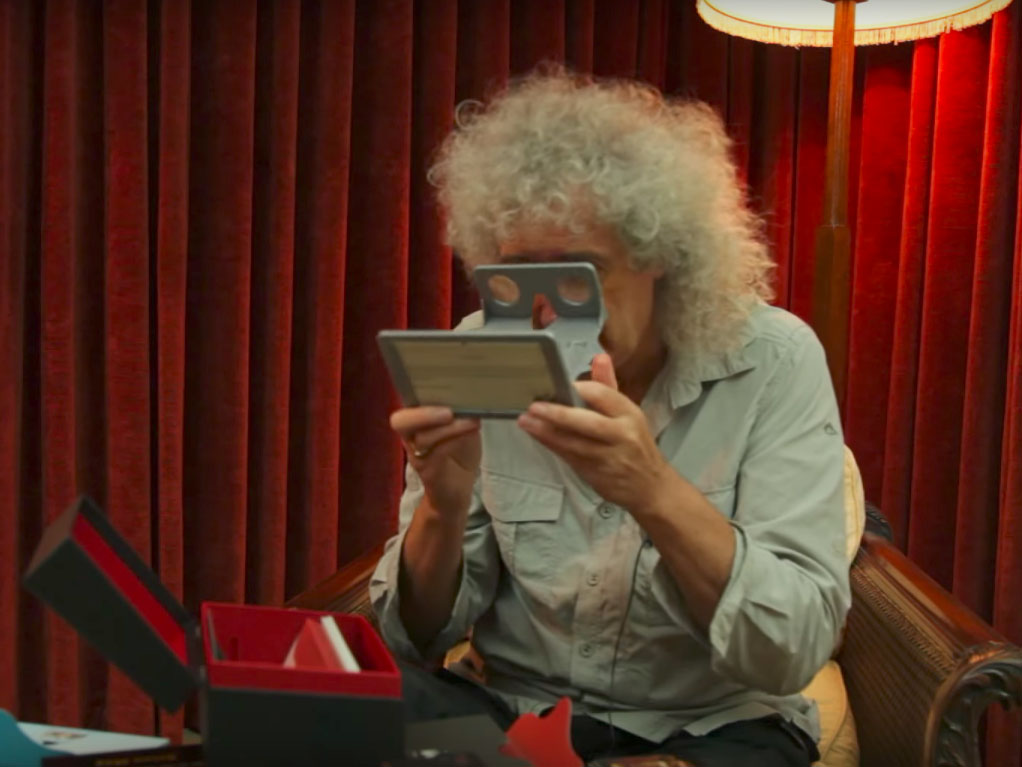24 May 2017 by James Cook

Brian May with a copy of his new book. Photo c.Phil Harmer
- Queen guitarist Brian May is releasing a book of 3D photographs that include photos of his childhood as well as his time in the band Queen.
- May is passionate about 3D — or stereo — photography and has designed his own 3D photo viewer.
- He wants to help Apple design a stereo camera for the iPhone and he owns “countless” virtual reality headsets.
Former Queen guitarist Brian May is one of the men behind some of the most well-known rock songs in history: “Bohemian Rhapsody,” “We Will Rock You,” and “Don’t Stop Me Now.” The list goes on. But May also has some surprising interests outside the world of rock music.
May has a PhD in astrophysics from Imperial College London, for example, regularly campaigns for animal rights, and is also a collector and publisher of stereoscopic photos — dual photographs which give a 3D effect when seen through special viewers.
Now May is releasing a new book, “Queen in 3-D,” which includes hundreds of stereo photographs of the band. It also comes with one of May’s “OWL” viewers, which let you see the photos in a 3D effect.
The venue for May’s book launch was the Century Club on Shaftesbury Avenue. May had taken over a room and filled it with a traveling museum of photography and Queen memorabilia.
There was an outfit worn on stage by May, a golden record given to him in 1975 for selling 250,000 copies of “Bohemian Rhapsody,” and an entire display of May’s stereoscopic cameras.
One display case held May’s first ever 3D camera, as well as several other bizarre-looking devices and a boxy 3D photo viewer that looks like an old-fashioned wireless radio. I would have taken my phone out to take a photo of it all for this article but I felt rather stupid taking a new-fangled, non-3D photo while May was stood a couple of metres away from me.
Eventually May and I sat down to talk about his new book. He wore a black jacket and a black shirt, and I found it difficult to judge where his curly grey hair actually ends.
I started off by asking May how he chose which photos to include in his book. May said he initially didn’t realise how many photographs he had, but gradually he and his team found more images to include.

May’s new book.The London Stereoscopic Company
“As soon as I started looking at these pictures I started to discover all kinds of memories in myself which I had no idea were still in my head,” May said. “Using the stereoscope and that feeling of being there, going through the window, the stereo window, and revisiting that time and that place. I found it very powerful. So all these stories came tumbling out of my head.”
The book follows Queen through their career, showing the band on stage, off stage, and in the recording studio. Some of the most striking photographs are of the band’s singer Freddie Mercury. “[There are] some great Freddie moments,” May said.
“The one of him taking a picture of me is great, because somewhere in the world is that Polaroid that he took of me while I’m taking the stereo picture of him. Maybe I’ll find it one day.”
What made May decide to document his life on the road? Was it an awareness of the importance of what Queen was doing, or just a desire to document the world around him? ” I don’t think I was consciously documenting at all,” May said. “I was just trying to take stereo pictures because I love them.”
But there were some exceptions. “I was conscious when we were making the ‘Radio Ga Ga’ video that that was a moment in time which would never be repeated and I did have the camera and I thought ‘ooh, it would be really nice to get a collection of pictures which would remind us of how it was done.’ So in that case, yeah, probably I was in a sense trying to accumulate some data. I wish I’d done more of that, to be honest.”
“But you’re busy, and the prime intent at the time is to do the job properly, which is entertaining people or making a record or standing on top of Buckingham Palace. Whatever it is, you’re pretty absorbed in the moment.”
May sees himself as a ‘stereoscopic evangelist’
Stereo photos have become almost a second career for May. He runs the London Stereoscopic Company which publishes his books, and he says he sees himself as “a stereoscopic evangelist.” “This is a dream come true for me,” May said.
But what is it about stereo photos that May finds so compelling? “To me it’s everything,” May said.
“I’m constantly surprised that people are satisfied with two-dimensional images, because we’re not two-dimensional creatures. Every day of our lives we experience the world in three dimensions and 360. So why wouldn’t we want to capture it that way when we take pictures? It seems to me, it’s kind of a no brainer. If you can do it in 3D it’s got to be a million times better than in 2D.”
To illustrate his point, May placed a hand over one of his eyes and stared at me over the table. “I’m losing so much of what could be coming into my brain. I take the hand away and I see you in three dimensions.”
May then encouraged me to do the same. “Go on, humour me,” he said. I placed a hand over one of my eyes and looked at him, unsure exactly what to say as we sat staring at each other.
“The amount of information you get from stereoscopic vision, stereopsis is the proper name for it, is colossally useful to us in our survival,” May told me.
“You need to know how far away something is when it’s coming to you … you need to know how big it is and which direction it’s traveling. And that’s how we evolved … There are very few creatures that survived with just one eye.”
May has an idea for what he’d like to see in an upcoming iPhone
I mentioned to May that the upcoming iPhone 8 is expected to have an improved dual camera setup on the back of the phone. Could that be useful for stereo photography?
May already knew all about the existing dual camera setup on the iPhone 7 Plus. “It has a dual camera but they’re not far apart enough to be a stereo camera. I actually did do a design for a stereoscopic iPhone about a year ago, but I’ve never managed to get in touch with anyone at Apple to talk about it,” he said.
I decided to break the bad news to May: The iPhone 8 is expected to change the orientation of the rear cameras so that they’re aligned vertically, not horizontally. He sounded disappointed. “That wouldn’t give you stereo if it’s vertical. You have to have horizontal parallax to get stereo.”

A leaked iPhone 8 dummy unit showing the vertical camera setup.Twitter/VenyaGeskin1
But May is still optimistic about his design for a new kind of iPhone camera. “It could be very easily done,” he said. “You have your two lenses. They have their two little lenses next to each other like that … you could immediately produce a side by side image on the back which you can immediately view on your OWL. You put it in your stereoscope here and it would be instant stereo photography.”
“I have to persuade them they can make money out of it,” May said, “because the world’s about money, isn’t it?” I suggested to May that perhaps someone from Apple would read this article and get in touch. “Maybe you can introduce me,” he said.
‘I’m into the whole VR thing’
Other than stereo photography and blogging on his website, which other areas of technology interest May? “Nothing, really,” he replied, before thinking for a moment. “That’s an interesting question. I’m into the whole VR thing. I have countless viewers and stuff.”
I asked May if he owns an Oculus Rift virtual reality headset. “Of course,” he replied. “They were pioneers.” He also owns one of Google’s low-cost Google Cardboard viewers.
May has developed his own low-cost virtual reality headset, a version of OWL which can hold a smartphone. “I think my OWL VR kit stands quite well among them,” he said. “It’s different … you have a longer focal length with the OWL and you have space around you so you’re conscious of the world that you’re physically in, as well as your virtual world.”

Brian May using one of his OWL viewers. YouTube/Brian May Official
May remains passionate about politics and animal rights
By this point we had been talking for longer than the time allotted to me, and I could feel other journalists and May’s PR team willing me to wrap things up.
I decided to end our interview the same way I end most interviews: I asked if there was anything else May wanted to mention. Usually this results in “no, I think that was everything,” or a reminder of whatever it was that the interviewee was promoting.
May, however, relished the chance to have his say on a topic of his choosing. He leaned towards my dictaphone, stared into it, and spoke for three minutes on what he saw as some of the biggest problems in the world right now.
“I’m very affected by what happened in Manchester last night,” May began. “To me it awakens lots of thoughts about our position in the world. Of course people say we need to tighten up security. Yes, of course we do, but you have to look at the underlying causes of this kind of behaviour and I believe that we are part of it.”
“I believe that we are part of the escalating violence in the world. And until we completely rethink our foreign policy and the way we treat other races, other human beings, then I believe this will only get worse.”
 Brian May campaigning outside Parliament in 2016. Getty Images News
Brian May campaigning outside Parliament in 2016. Getty Images News
May mentioned Brexit alongside “intolerance” and “disengaging from our fellow man.” He had a personal litmus test, he said, which is how people feel about blood sports such as fox hunting. “Most people who are in favour of blood sports are inherently violently disposed,” he claimed, “and those are exactly the same kind of people who feel no compassion towards human beings either.”
He drew my attention to the badge he wore on his jacket. It looked like an oversized prefect’s badge, but with a diagonal rainbow background and the phrase “COMMON DECENCY” printed across it in capital letters. “I have my campaign here called Common Decency in which I’m asking people in this coming election, not to vote for a party, but to vote for a person that they believe is decent.”
May said he felt that Parliament should be a “moderating influence,” but “at the moment, it’s on the verge of failure and I think this country’s on the verge of failure because of it.”
And that was the end of May’s unexpected message. Now we had definitely gone over time. We shook hands and I left him to the rest of his interviews, happy amongst his stereo photographs.
“Queen in 3-D,” by Brian May, published by The London Stereoscopic Company, £50, is released on May 25.
